Delivery - Hack The Box

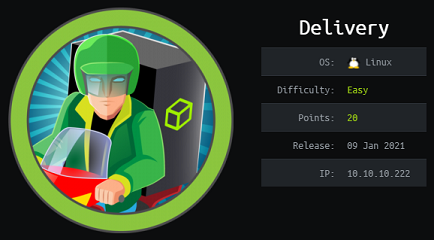 Delivery is a quick and fun easy box where we have to create a MatterMost account and validate it by using automatic email accounts created by the OsTicket application. The admins on this platform have very poor security practices and put plaintext credentials in MatterMost. Once we get the initial shell with the creds from MatterMost we’ll poke around MySQL and get a root password bcrypt hash. Using a hint left in the MatterMost channel about the password being a variation of PleaseSubscribe!, we’ll use hashcat combined with rules to crack the password then get the root shell.
Delivery is a quick and fun easy box where we have to create a MatterMost account and validate it by using automatic email accounts created by the OsTicket application. The admins on this platform have very poor security practices and put plaintext credentials in MatterMost. Once we get the initial shell with the creds from MatterMost we’ll poke around MySQL and get a root password bcrypt hash. Using a hint left in the MatterMost channel about the password being a variation of PleaseSubscribe!, we’ll use hashcat combined with rules to crack the password then get the root shell.
 Ready was a pretty straighforward box to get an initial shell on: We identify that’s it running a vulnerable instance of Gitlab and we use an exploit against version 11.4.7 to land a shell. Once inside, we quickly figure out we’re in a container and by looking at the docker compose file we can see the container is running in privileged mode. We then mount the host filesystem within the container then we can access the flag or add our SSH keys to the host root user home directory.
Ready was a pretty straighforward box to get an initial shell on: We identify that’s it running a vulnerable instance of Gitlab and we use an exploit against version 11.4.7 to land a shell. Once inside, we quickly figure out we’re in a container and by looking at the docker compose file we can see the container is running in privileged mode. We then mount the host filesystem within the container then we can access the flag or add our SSH keys to the host root user home directory.
 To solve Unbalanced, we’ll find configuration backups files in EncFS and after cracking the password and figuring out how EncFS works, we get the Squid proxy cache manager password that let us discover internal hosts. Proxying through Squid, we then land on a login page that uses Xpath to query an XML backend database. We perform Xpath injection to retrieve the password of each user, then port forward through the SSH shell to reach a Pi-Hole instance, vulnerable to a command injection vulnerability.
To solve Unbalanced, we’ll find configuration backups files in EncFS and after cracking the password and figuring out how EncFS works, we get the Squid proxy cache manager password that let us discover internal hosts. Proxying through Squid, we then land on a login page that uses Xpath to query an XML backend database. We perform Xpath injection to retrieve the password of each user, then port forward through the SSH shell to reach a Pi-Hole instance, vulnerable to a command injection vulnerability.
 Buff is pretty straightforward: Use a public exploit against the Gym Management System, then get RCE. Do some port-forwarding, then use another exploit (buffer overflow against Cloudme Sync) to get Administrator access.
Buff is pretty straightforward: Use a public exploit against the Gym Management System, then get RCE. Do some port-forwarding, then use another exploit (buffer overflow against Cloudme Sync) to get Administrator access.
 Intense starts with code review of a flask application where we find an SQL injection vulnerability that we exploit with a time-based technique. After retrieving the admin hash, we’ll use a hash length extension attack to append the admin username and hash that we found in the database, while keeping the signature valid, then use a path traversal vulnerability to read the snmp configuration file. With the SNMP read-write community string we can execute commands with the daemon user. To escalate to root, we’ll create an SNMP configuration file with the agentUser set to root, then wait for the SNMP daemon to restart to so we can execute commands as root.
Intense starts with code review of a flask application where we find an SQL injection vulnerability that we exploit with a time-based technique. After retrieving the admin hash, we’ll use a hash length extension attack to append the admin username and hash that we found in the database, while keeping the signature valid, then use a path traversal vulnerability to read the snmp configuration file. With the SNMP read-write community string we can execute commands with the daemon user. To escalate to root, we’ll create an SNMP configuration file with the agentUser set to root, then wait for the SNMP daemon to restart to so we can execute commands as root.
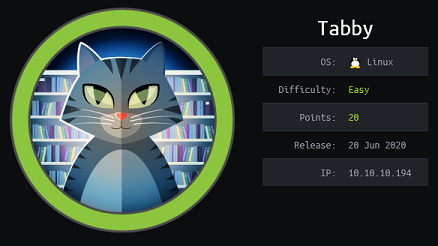 Tabby was an easy box with simple PHP arbitrary file ready, some password cracking, password re-use and abusing LXD group permissions to instantiate a new container as privileged and get root access. I had some trouble finding the tomcat-users.xml file so installed Tomcat locally on my VM and found the proper path for the file.
Tabby was an easy box with simple PHP arbitrary file ready, some password cracking, password re-use and abusing LXD group permissions to instantiate a new container as privileged and get root access. I had some trouble finding the tomcat-users.xml file so installed Tomcat locally on my VM and found the proper path for the file.
 To solve Fuse, we’ll do some enumeration to gather potential usernames from the print jobs information then build a password list from the strings on the website. After successfully password spraying, we’ll reset the expired password to a new one then use rpcclient to identify a printer service account and find its password in a description field. To priv esc, we’ll use the ability of our user with Printer Operators right to load a malicous kernel driver and get SYSTEM.
To solve Fuse, we’ll do some enumeration to gather potential usernames from the print jobs information then build a password list from the strings on the website. After successfully password spraying, we’ll reset the expired password to a new one then use rpcclient to identify a printer service account and find its password in a description field. To priv esc, we’ll use the ability of our user with Printer Operators right to load a malicous kernel driver and get SYSTEM.
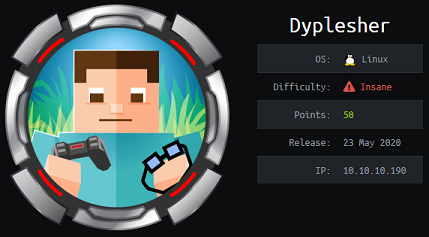 Dyplesher was a pretty tough box that took me more than 10 hours to get to the user flag. There’s quite a bit of enumeration required to get to the git repo and then find memcached credentials from the source code. I couldn’t use the memcache module from Metasploit here since it doesn’t support credentials so I wrote my own memcache enumeration script. We then make our way to more creds in Gogs, then craft a malicious Minecraft plugin to get RCE. To get to the first flag we’ll sniff AMQP creds from the loopback interface. To priv esc, we send messages on the RabbitMQ bug and get the server to download and execute a lua script (Cubberite plugin).
Dyplesher was a pretty tough box that took me more than 10 hours to get to the user flag. There’s quite a bit of enumeration required to get to the git repo and then find memcached credentials from the source code. I couldn’t use the memcache module from Metasploit here since it doesn’t support credentials so I wrote my own memcache enumeration script. We then make our way to more creds in Gogs, then craft a malicious Minecraft plugin to get RCE. To get to the first flag we’ll sniff AMQP creds from the loopback interface. To priv esc, we send messages on the RabbitMQ bug and get the server to download and execute a lua script (Cubberite plugin).
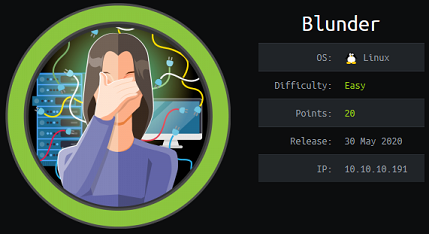 Blunder was an easy box for beginners that required bruteforcing the login for a Bludit CMS, then exploiting a known CVE through Metasploit to get remote code execution. The priv esc is a neat little CVE with sudo that allows us to execute commands as root even though the root username is supposed to be blocked.
Blunder was an easy box for beginners that required bruteforcing the login for a Bludit CMS, then exploiting a known CVE through Metasploit to get remote code execution. The priv esc is a neat little CVE with sudo that allows us to execute commands as root even though the root username is supposed to be blocked.
 On Cache, we start off with bypassing a simple login form that uses client-side user/password validation, then find a vhost with a vulnerable OpenEMR application. After bypassing the login page, obtaining a valid session cookie and dumping the database through a SQLi injection vulnerability we exploit yet another OpenEMR CVE to get a shell. From there we have access to a memcache instance holding more credentials in memory so we can escalate to another user. Using the docker group membership of that last user, we’re able to launch a privileged container and get root privileges on the host itself.
On Cache, we start off with bypassing a simple login form that uses client-side user/password validation, then find a vhost with a vulnerable OpenEMR application. After bypassing the login page, obtaining a valid session cookie and dumping the database through a SQLi injection vulnerability we exploit yet another OpenEMR CVE to get a shell. From there we have access to a memcache instance holding more credentials in memory so we can escalate to another user. Using the docker group membership of that last user, we’re able to launch a privileged container and get root privileges on the host itself.
 Blackfield was a fun Windows box where we get a list of potential usernames from an open SMB share, validate that list using kerbrute, then find and crack the hash of an account with the AS-REProasting technique. After getting that first user, we’ll use Bloodhound to discover that we can change another account’s password, then from there access a previously locked down SMB share, retrieve an LSASS dump file and get more credentials. For the last part of the box we’ll abuse the Backup Operators role to download a copy of the NTDS.dit file and recover the administrator NT hash.
Blackfield was a fun Windows box where we get a list of potential usernames from an open SMB share, validate that list using kerbrute, then find and crack the hash of an account with the AS-REProasting technique. After getting that first user, we’ll use Bloodhound to discover that we can change another account’s password, then from there access a previously locked down SMB share, retrieve an LSASS dump file and get more credentials. For the last part of the box we’ll abuse the Backup Operators role to download a copy of the NTDS.dit file and recover the administrator NT hash.
 Admirer is an easy box with the typical ‘gobuster/find creds on the webserver’ part, but after we use a Rogue MySQL server to read files from the server file system, then for privesc there’s a cool sudo trick with environment variables so we can hijack the python library path and get RCE as root.
Admirer is an easy box with the typical ‘gobuster/find creds on the webserver’ part, but after we use a Rogue MySQL server to read files from the server file system, then for privesc there’s a cool sudo trick with environment variables so we can hijack the python library path and get RCE as root.
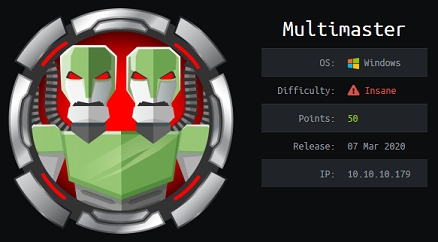 Multimaster was a challenging Windows machine that starts with an SQL injection so we can get a list of hashes. The box author threw a little curve ball here and it took me a while to figure that the hash type was Keccak-384, and not SHA-384. After successfully spraying the cracked password, we exploit a local command execution vulnerability in VS Code, then find a password in a DLL file, perform a targeted Kerberoasting attack and finally use our Server Operators group membership to get the flag.
Multimaster was a challenging Windows machine that starts with an SQL injection so we can get a list of hashes. The box author threw a little curve ball here and it took me a while to figure that the hash type was Keccak-384, and not SHA-384. After successfully spraying the cracked password, we exploit a local command execution vulnerability in VS Code, then find a password in a DLL file, perform a targeted Kerberoasting attack and finally use our Server Operators group membership to get the flag.
 Travel is an awesome box from my ATeam teammates xct and jkr. The box has a code review part where we analyze the source code of a PHP web app to find a command injection vulnerability in a curl command. We then use the Gopher protocol to perform SSRF and write a serialized PHP payload into the memcache database. For the priv esc part, we manipulate attributes of a user in an LDAP database which is used by the NSS facility to extend the Linux authentication database.
Travel is an awesome box from my ATeam teammates xct and jkr. The box has a code review part where we analyze the source code of a PHP web app to find a command injection vulnerability in a curl command. We then use the Gopher protocol to perform SSRF and write a serialized PHP payload into the memcache database. For the priv esc part, we manipulate attributes of a user in an LDAP database which is used by the NSS facility to extend the Linux authentication database.
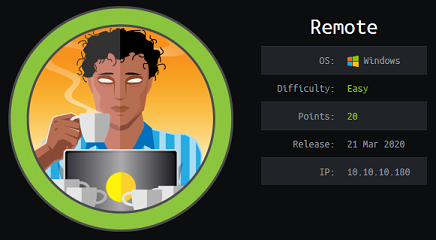 Remote is a beginner’s box running a vulnerable version of the Umbraco CMS which can be exploited after we find the credentials from an exposed share. After landing a reverse shell, we find that the machine has TeamViewer installed and we can recover the password with Metasploit then log in as Administrator.
Remote is a beginner’s box running a vulnerable version of the Umbraco CMS which can be exploited after we find the credentials from an exposed share. After landing a reverse shell, we find that the machine has TeamViewer installed and we can recover the password with Metasploit then log in as Administrator.
 Quick was a hard box with multiple steps requiring the use of the QUIC protocol to access one section of the website and get the customer onboarding PDF with a set of default credentials. We get to play with ESI template injection to get the initial shell, then abuse a race condition in a PHP script so we can pivot to another user then finally we priv esc to root by finding credentials in the printer configuration file.
Quick was a hard box with multiple steps requiring the use of the QUIC protocol to access one section of the website and get the customer onboarding PDF with a set of default credentials. We get to play with ESI template injection to get the initial shell, then abuse a race condition in a PHP script so we can pivot to another user then finally we priv esc to root by finding credentials in the printer configuration file.
 Magic starts with a classic PHP insecure upload vulnerability that let us place a webshell on the target host and then we exploit a subtle webserver misconfiguration to execute the webshell (even though the file name doesn’t end with a .php extension). Once we land a shell, we escalate to another user with credentials found in MySQL and priv esc to root by exploiting a path hijack vulnerability in a SUID binary.
Magic starts with a classic PHP insecure upload vulnerability that let us place a webshell on the target host and then we exploit a subtle webserver misconfiguration to execute the webshell (even though the file name doesn’t end with a .php extension). Once we land a shell, we escalate to another user with credentials found in MySQL and priv esc to root by exploiting a path hijack vulnerability in a SUID binary.
 Traceback was an easy box where you had to look for an existing webshell on the box, then use it to get the initial foothold. Then there was some typical sudo stuff with a LUA interpreter giving us access as another user then for privesc we find that we can write to /etc/update-motd.d and those scripts get executed by root.
Traceback was an easy box where you had to look for an existing webshell on the box, then use it to get the initial foothold. Then there was some typical sudo stuff with a LUA interpreter giving us access as another user then for privesc we find that we can write to /etc/update-motd.d and those scripts get executed by root.
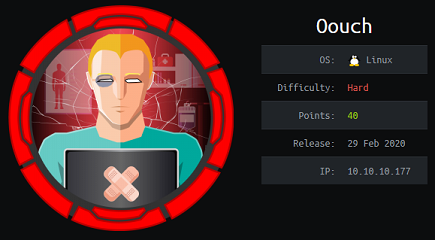 Ooauth was a pretty tough box because I was unfamiliar with Oauth and it took a while to figure out the bits and pieces to chain together. The priv esc was pretty cool, we had to talk to the uwsgi socket directly to manipulate the REMOTE_ADDR variable and exploit a command injection vulnerability in the script calling iptables.
Ooauth was a pretty tough box because I was unfamiliar with Oauth and it took a while to figure out the bits and pieces to chain together. The priv esc was pretty cool, we had to talk to the uwsgi socket directly to manipulate the REMOTE_ADDR variable and exploit a command injection vulnerability in the script calling iptables.
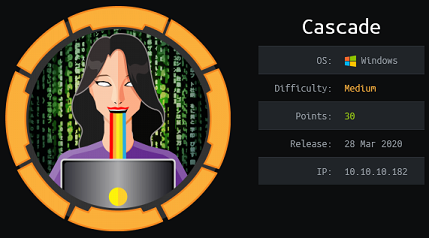 Cascade was a simple and straightforward enumeration-focused Windows box. We find the credentials for the initial account in a custom LDAP attibute then enumerate SMB shares, finding VNC credentials which can be decrypted. With those creds we find an SQlite database that contains encrypted credentials for yet another user. To decrypt the password we have to reverse a simple .NET application located on one of the shares. The final privesc involves getting the admin password from tombstone, a feature in AD that keeps deleted objects for a period of time.
Cascade was a simple and straightforward enumeration-focused Windows box. We find the credentials for the initial account in a custom LDAP attibute then enumerate SMB shares, finding VNC credentials which can be decrypted. With those creds we find an SQlite database that contains encrypted credentials for yet another user. To decrypt the password we have to reverse a simple .NET application located on one of the shares. The final privesc involves getting the admin password from tombstone, a feature in AD that keeps deleted objects for a period of time.
 Sauna is a good beginner-friendly AD box that covers a few key Windows exploitation topics like AS-REP roasting, enumeration for credentials, using tools such as Powerview to find attack paths, DCsync and Pass-The-Hash techniques.
Sauna is a good beginner-friendly AD box that covers a few key Windows exploitation topics like AS-REP roasting, enumeration for credentials, using tools such as Powerview to find attack paths, DCsync and Pass-The-Hash techniques.
 I initially thought for Book that the goal was to get the administrator’s session cookie via an XSS but instead we have to create a duplicate admin account by using a long email address that gets truncated to the existing one. Once we have access to the admin page we then exploit an XSS vulnerability in the PDF generator to read SSH keys for the low priv user. We priv esc using a race condition vulnerability in logrotate so we can backdoor /etc/bash_completion.d.
I initially thought for Book that the goal was to get the administrator’s session cookie via an XSS but instead we have to create a duplicate admin account by using a long email address that gets truncated to the existing one. Once we have access to the admin page we then exploit an XSS vulnerability in the PDF generator to read SSH keys for the low priv user. We priv esc using a race condition vulnerability in logrotate so we can backdoor /etc/bash_completion.d.
 Forwardslash starts off like most classic Hack The Box machines with some enumeration of vhosts, files and directories with gobuster then we use a Server-Side Request Forgery (SSRF) vulnerability to reach a protected dev directory only accessible from localhost. After finding credentials and getting a shell, we’ll analyze and exploit a small backup program to read files as user pain and find more credentials. In the spirit of Team Unintended, instead of solving the crypto challenge to get root I used the sudo commands available to me to upload and mount my own Luks container and execute a SUID bash binary.
Forwardslash starts off like most classic Hack The Box machines with some enumeration of vhosts, files and directories with gobuster then we use a Server-Side Request Forgery (SSRF) vulnerability to reach a protected dev directory only accessible from localhost. After finding credentials and getting a shell, we’ll analyze and exploit a small backup program to read files as user pain and find more credentials. In the spirit of Team Unintended, instead of solving the crypto challenge to get root I used the sudo commands available to me to upload and mount my own Luks container and execute a SUID bash binary.
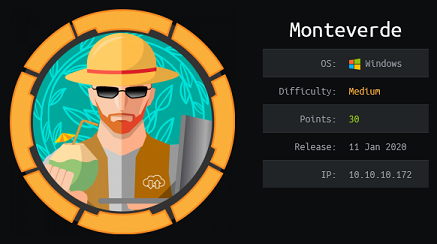 Monteverde was an Active Directory box on the easier side that requires enumerating user accounts then password spraying to get an initial shell. Then we find more credentials looking around the box and eventually find the MSOL account password which we use to get administrator access.
Monteverde was an Active Directory box on the easier side that requires enumerating user accounts then password spraying to get an initial shell. Then we find more credentials looking around the box and eventually find the MSOL account password which we use to get administrator access.
 Professional Offensive Operations (P.O.O.) was the first endgame lab released by Hack The Box. It contained five different flags spread across two Windows machines. The initial part required some tricky recon with ds_store and IIS short names to find a MSSQL DB connection string. We then had to pivot by abusing the trust between MSSQL linked servers. The lab also had kerberoasting, password cracking, mimikatz and attack path enumeration with Bloodhound in it.
Professional Offensive Operations (P.O.O.) was the first endgame lab released by Hack The Box. It contained five different flags spread across two Windows machines. The initial part required some tricky recon with ds_store and IIS short names to find a MSSQL DB connection string. We then had to pivot by abusing the trust between MSSQL linked servers. The lab also had kerberoasting, password cracking, mimikatz and attack path enumeration with Bloodhound in it.
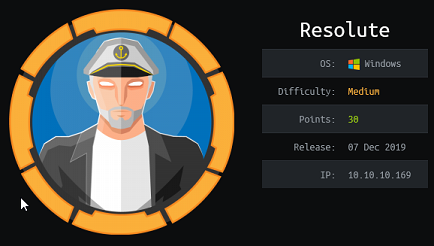 We start Resolute with enumeration of the domain user accounts using an anonymous bind session to the LDAP server and find an initial password in the description field of one of the account. Password spraying the password against all the discovered accounts give us an initial shell then we pivot to another user after finding creds in a console history file. The priv esc is pretty cool: we’re in the DNS admins group so we can reconfigure the DNS service to run an arbitrary DLL as SYSTEM.
We start Resolute with enumeration of the domain user accounts using an anonymous bind session to the LDAP server and find an initial password in the description field of one of the account. Password spraying the password against all the discovered accounts give us an initial shell then we pivot to another user after finding creds in a console history file. The priv esc is pretty cool: we’re in the DNS admins group so we can reconfigure the DNS service to run an arbitrary DLL as SYSTEM.
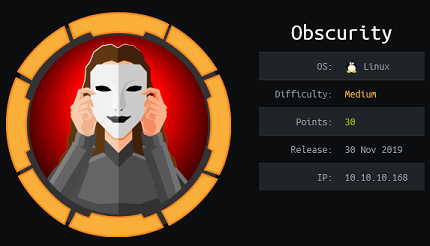 The Obscurity box has a vulnerable Python web application running. After finding the source code from a secret directory we find that the exec call can be command injected to get a shell as www-data. Then we have to solve a simple crypto challenge to retrieve an encryption key that decrypts a file containing the robert user’s password. We finally get root by exploiting a race condition in a python script so that we can copy the /etc/shadow file and crack the root password.
The Obscurity box has a vulnerable Python web application running. After finding the source code from a secret directory we find that the exec call can be command injected to get a shell as www-data. Then we have to solve a simple crypto challenge to retrieve an encryption key that decrypts a file containing the robert user’s password. We finally get root by exploiting a race condition in a python script so that we can copy the /etc/shadow file and crack the root password.
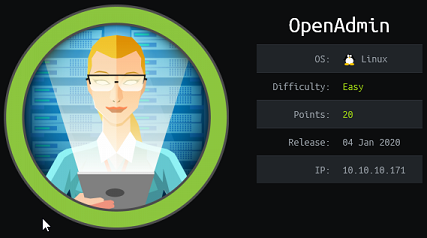 OpenAdmin is an easy box that starts with using an exploit for the OpenNetAdmin software to get initial RCE. Then we get credentials from the database config and can re-use them to connect by SSH. We then find another web application with an hardcoded SHA512 hash in the PHP code for the login page. After cracking it we’re able to log in and obtain an encrypted SSH key that we have to crack. After getting one more shell, we can run nano as root with sudo and spawn a shell as root.
OpenAdmin is an easy box that starts with using an exploit for the OpenNetAdmin software to get initial RCE. Then we get credentials from the database config and can re-use them to connect by SSH. We then find another web application with an hardcoded SHA512 hash in the PHP code for the login page. After cracking it we’re able to log in and obtain an encrypted SSH key that we have to crack. After getting one more shell, we can run nano as root with sudo and spawn a shell as root.
 Control runs a vulnerable PHP web application that controls access to the admin page by checking the X-Forwarded-For HTTP header. By adding the X-Forwarded-For HTTP header with the right IP address we can access the admin page and exploit an SQL injection to write a webshell and get RCE. After pivoting to another user with the credentials found in the MySQL database, we get SYSTEM access by modifying an existing service configuration from the registry.
Control runs a vulnerable PHP web application that controls access to the admin page by checking the X-Forwarded-For HTTP header. By adding the X-Forwarded-For HTTP header with the right IP address we can access the admin page and exploit an SQL injection to write a webshell and get RCE. After pivoting to another user with the credentials found in the MySQL database, we get SYSTEM access by modifying an existing service configuration from the registry.
 Mango was a medium box with a NoSQSL injection in the login page that allows us to retrieve the username and password. The credentials we retrieve through the injection can be used to SSH to the box. For privilege escalation, the jjs tool has the SUID bit set so we can run scripts as root.
Mango was a medium box with a NoSQSL injection in the login page that allows us to retrieve the username and password. The credentials we retrieve through the injection can be used to SSH to the box. For privilege escalation, the jjs tool has the SUID bit set so we can run scripts as root.
 Sometimes you need a break from the hard boxes that take forever to pwn. Traverxec is an easy box that start with a custom vulnerable webserver with an unauthenticated RCE that we exploit to land an initial shell. After pivoting to another user by finding his SSH private key and cracking it, we get root through the less pager invoked by journalctl running as root through sudo.
Sometimes you need a break from the hard boxes that take forever to pwn. Traverxec is an easy box that start with a custom vulnerable webserver with an unauthenticated RCE that we exploit to land an initial shell. After pivoting to another user by finding his SSH private key and cracking it, we get root through the less pager invoked by journalctl running as root through sudo.
 This writeup is outdated and the attack path presented for user bolt has been patched. Initially once we pivoted from the bolt user to www-data we could run restic as root and abuse the sftp.command parameter to execute any command as root.
This writeup is outdated and the attack path presented for user bolt has been patched. Initially once we pivoted from the bolt user to www-data we could run restic as root and abuse the sftp.command parameter to execute any command as root.
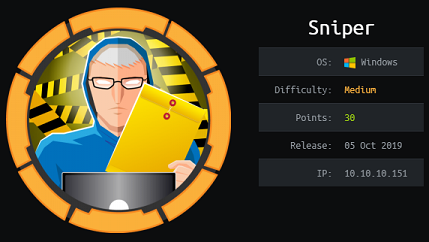 Sniper is another box I got access to through an unintended method. The PHP application wasn’t supposed to be exploitable through Remote File Inclusion but because it runs on Windows, we can use UNC path to include a file from an SMB share. Once I had a shell, I pivoted using plink and logged in as user Chris with WinRM. The box author was nice enough to leave hints as to what kind of malicious payload was expected and I used Nishang to generate a CHM payload and get Administrator access.
Sniper is another box I got access to through an unintended method. The PHP application wasn’t supposed to be exploitable through Remote File Inclusion but because it runs on Windows, we can use UNC path to include a file from an SMB share. Once I had a shell, I pivoted using plink and logged in as user Chris with WinRM. The box author was nice enough to leave hints as to what kind of malicious payload was expected and I used Nishang to generate a CHM payload and get Administrator access.
 Forest is a nice easy box that go over two Active Directory misconfigurations / vulnerabilities: Kerberos Pre-Authentication (disabled) and ACLs misconfiguration. After I retrieve and cracked the hash for the service account I used aclpwn to automate the attack path and give myself DCsync rights to the domain.
Forest is a nice easy box that go over two Active Directory misconfigurations / vulnerabilities: Kerberos Pre-Authentication (disabled) and ACLs misconfiguration. After I retrieve and cracked the hash for the service account I used aclpwn to automate the attack path and give myself DCsync rights to the domain.
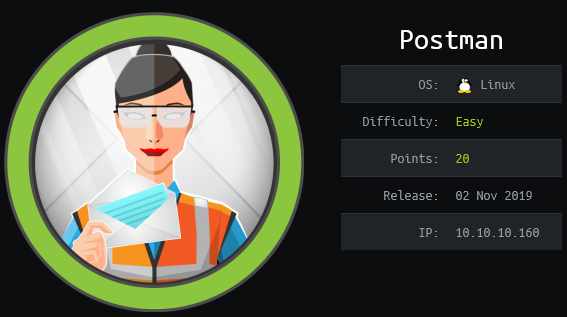 Postman was a somewhat frustrating box because we had to find the correct user directory where to write our SSH key using the unprotected Redis instance. I expected to be able to use a wordlist to scan through /home and find a valid user but on this box the redis user was configured with a valid login shell so I had to guess that and write my SSH key to /var/lib/redis/.ssh instead. The rest of the box was pretty straightforward, crack some SSH private key then pop a root shell with a Webmin CVE.
Postman was a somewhat frustrating box because we had to find the correct user directory where to write our SSH key using the unprotected Redis instance. I expected to be able to use a wordlist to scan through /home and find a valid user but on this box the redis user was configured with a valid login shell so I had to guess that and write my SSH key to /var/lib/redis/.ssh instead. The rest of the box was pretty straightforward, crack some SSH private key then pop a root shell with a Webmin CVE.
 Bankrobber is a web app box with a simple XSS and SQL injection that we have to exploit in order to get the source code of the application and discover a command injection vulnerability in the backdoor checker page that’s only reachable from localhost. By using the XSS to make a local request to that page, we can get land a shell on the box. To get root, we exploit a buffer in an application to override the name of the binary launched by the program.
Bankrobber is a web app box with a simple XSS and SQL injection that we have to exploit in order to get the source code of the application and discover a command injection vulnerability in the backdoor checker page that’s only reachable from localhost. By using the XSS to make a local request to that page, we can get land a shell on the box. To get root, we exploit a buffer in an application to override the name of the binary launched by the program.
 Zetta is another amazing box by jkr. The first part was kinda tricky because you had to pay attention to the details on the webpage and spot the references to IPv6 that lead you to the EPTR command to disclose the IPv6 address of the server. Then there’s some light bruteforcing of rsync’s credentials with a custom bruteforce script and finally a really cool SQL injection in a syslog PostgreSQL module.
Zetta is another amazing box by jkr. The first part was kinda tricky because you had to pay attention to the details on the webpage and spot the references to IPv6 that lead you to the EPTR command to disclose the IPv6 address of the server. Then there’s some light bruteforcing of rsync’s credentials with a custom bruteforce script and finally a really cool SQL injection in a syslog PostgreSQL module.
 To get remote code execution on JSON, I exploited a deserialization vulnerability in the web application using the Json.net formatter. After getting a shell I could either get a quick SYSTEM shell by abusing SeImpersonatePrivileges with Juicy Potato or reverse the Sync2FTP application to decrypt its configuration and find the superadmin user credentials.
To get remote code execution on JSON, I exploited a deserialization vulnerability in the web application using the Json.net formatter. After getting a shell I could either get a quick SYSTEM shell by abusing SeImpersonatePrivileges with Juicy Potato or reverse the Sync2FTP application to decrypt its configuration and find the superadmin user credentials.
 I had fun solving RE but I did it using an unintended path. After getting a shell with a macroed .ods file, I saw that the Winrar version had a CVE which allowed me to drop a webshell in the webserver path and get RCE as iis apppool\re. The user had access to modify the UsoSvc service running with SYSTEM privileges so it was trivial at that point to get a SYSTEM shell. Because the root flag was encrypted for user Coby, I used meterpreter to impersonate his token and read the file.
I had fun solving RE but I did it using an unintended path. After getting a shell with a macroed .ods file, I saw that the Winrar version had a CVE which allowed me to drop a webshell in the webserver path and get RCE as iis apppool\re. The user had access to modify the UsoSvc service running with SYSTEM privileges so it was trivial at that point to get a SYSTEM shell. Because the root flag was encrypted for user Coby, I used meterpreter to impersonate his token and read the file.
 During the holidays, @stackfault (sysop from the BottomlessAbyss BBS) ran a month long CTF with challenges being released every couple of days. Some of challenges were unsolved or partially solved challenges from earlier HackFest editions as well as some new ones. There was also a point depreciation system in place so challenges solved earlier gave more points. This post is a writeup for the Evilconneck challenge, a quick but fun challenge with websockets and a bit of crypto.
During the holidays, @stackfault (sysop from the BottomlessAbyss BBS) ran a month long CTF with challenges being released every couple of days. Some of challenges were unsolved or partially solved challenges from earlier HackFest editions as well as some new ones. There was also a point depreciation system in place so challenges solved earlier gave more points. This post is a writeup for the Evilconneck challenge, a quick but fun challenge with websockets and a bit of crypto.
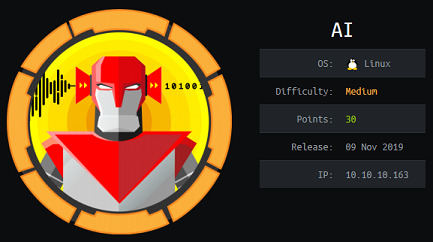 Exploiting the simple SQL injection vulnerability on the AI box was harder than expected because of the text-to-speech conversion required. I had to use a few tricks to inject the single quote in the query and the other parameters needed for the injection.
Exploiting the simple SQL injection vulnerability on the AI box was harder than expected because of the text-to-speech conversion required. I had to use a few tricks to inject the single quote in the query and the other parameters needed for the injection.
 Player was a tough one. Getting the initial shell on Player took me quite some time. Every time I got new credentials I thought I would be able to log in but there was always another step after. The trickiest part of the box for me was finding the .php~ extension to read the source code of the page. I had the hint from the chat application but I couldn’t connect the dots.
Player was a tough one. Getting the initial shell on Player took me quite some time. Every time I got new credentials I thought I would be able to log in but there was always another step after. The trickiest part of the box for me was finding the .php~ extension to read the source code of the page. I had the hint from the chat application but I couldn’t connect the dots.
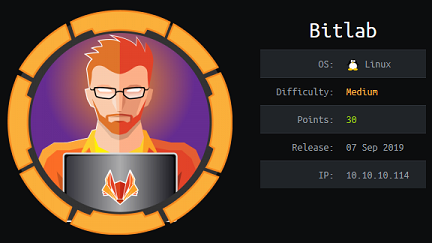 I solved this gitlab box the unintended way by exploiting the git pull command running as root and using git post-merge hooks to execute code as root. I was able to get a root shell using this method but I still had to get an initial shell by finding the gitlab credentials in some obfuscated javascript and modifying PHP code in the repo to get RCE.
I solved this gitlab box the unintended way by exploiting the git pull command running as root and using git post-merge hooks to execute code as root. I was able to get a root shell using this method but I still had to get an initial shell by finding the gitlab credentials in some obfuscated javascript and modifying PHP code in the repo to get RCE.
 Craft was a fun Silicon Valley themed box where we have to exploit a vulnerable REST API eval function call to get RCE. After getting a shell on the app container, we escalate to a user shell on the host OS by finding credentials and SSH private keys. To gain root access, we have to generate an OTP token with the vault software installed on the machine.
Craft was a fun Silicon Valley themed box where we have to exploit a vulnerable REST API eval function call to get RCE. After getting a shell on the app container, we escalate to a user shell on the host OS by finding credentials and SSH private keys. To gain root access, we have to generate an OTP token with the vault software installed on the machine.
 Just its predecessor, Smasher2 is a very difficult box with reverse engineering and binary exploitation. Unfortunately, the initial step required some insane brute-forcing which took part of the fun out of this one for me. I solved the authentication bypass part using an unintended method: The code compares the password against the username instead of the password in the configuration file so by guessing the username I also had the password and could log in. I had to do some WAF evasion to get my payload uploaded and land a shell. Then the final part of the box is exploiting a kernel driver mmap handler to change the credential structure in memory of my current user to get root access.
Just its predecessor, Smasher2 is a very difficult box with reverse engineering and binary exploitation. Unfortunately, the initial step required some insane brute-forcing which took part of the fun out of this one for me. I solved the authentication bypass part using an unintended method: The code compares the password against the username instead of the password in the configuration file so by guessing the username I also had the password and could log in. I had to do some WAF evasion to get my payload uploaded and land a shell. Then the final part of the box is exploiting a kernel driver mmap handler to change the credential structure in memory of my current user to get root access.
 Wall is running a vulnerable version of the Centreon application that allows authenticated users to gain RCE. The tricky part of this box was finding the path to the application since it’s not something that normally shows up in the wordlists I use with gobuster. The intended way was to bypass the HTTP basic auth by using a POST then the redirection contained a link to the centreon page but instead I did some recon on the box creator’s website and saw that he had written an exploit for Centreon and guessed the path accordingly. The priv esc was the same used on Flujab: a vulnerability in screen that allows the attacker to write to any file on the system.
Wall is running a vulnerable version of the Centreon application that allows authenticated users to gain RCE. The tricky part of this box was finding the path to the application since it’s not something that normally shows up in the wordlists I use with gobuster. The intended way was to bypass the HTTP basic auth by using a POST then the redirection contained a link to the centreon page but instead I did some recon on the box creator’s website and saw that he had written an exploit for Centreon and guessed the path accordingly. The priv esc was the same used on Flujab: a vulnerability in screen that allows the attacker to write to any file on the system.
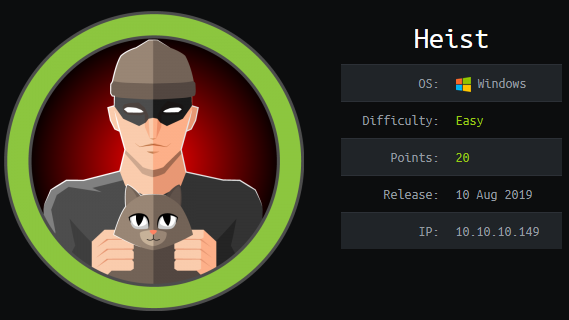 Heist starts off with a support page with a username and a Cisco IOS config file containing hashed & encrypted passwords. After cracking two passwords from the config file and getting access to RPC on the Windows machine, I find additional usernames by RID cycling and then password spray to find a user that has WinRM access. Once I have a shell, I discover a running Firefox process and dump its memory to disk so I can do some expert-level forensics (ie: running strings) to find the administrator password.
Heist starts off with a support page with a username and a Cisco IOS config file containing hashed & encrypted passwords. After cracking two passwords from the config file and getting access to RPC on the Windows machine, I find additional usernames by RID cycling and then password spray to find a user that has WinRM access. Once I have a shell, I discover a running Firefox process and dump its memory to disk so I can do some expert-level forensics (ie: running strings) to find the administrator password.
 I learned a bit about Ethereum and smart contracts while doing the Chainsaw box from Hack the Box. There’s a command injection vulnerability in a smart contract that gives me a shell. Then after doing some googling on IPFS filesystem, I find an encrypted SSH key for another user which I can crack. To get root access I use another smart contract to change the password used by a SUID binary running as root, then find the flag hidden in the slack space for root.txt
I learned a bit about Ethereum and smart contracts while doing the Chainsaw box from Hack the Box. There’s a command injection vulnerability in a smart contract that gives me a shell. Then after doing some googling on IPFS filesystem, I find an encrypted SSH key for another user which I can crack. To get root access I use another smart contract to change the password used by a SUID binary running as root, then find the flag hidden in the slack space for root.txt
 Networked was an easy box that starts off with a classic insecure upload vulnerability in an image gallery web application. The Apache server is misconfigured and let me use a double extension to get remote code execution through my PHP script. To escalate to root, we have to find a command injection vulnerability in the script that checks for web application attacks, then exploit another script running as root that changes the ifcfg file.
Networked was an easy box that starts off with a classic insecure upload vulnerability in an image gallery web application. The Apache server is misconfigured and let me use a double extension to get remote code execution through my PHP script. To escalate to root, we have to find a command injection vulnerability in the script that checks for web application attacks, then exploit another script running as root that changes the ifcfg file.
 The entrypoint for Jarvis is an SQL injection vulnerability in the web application to book hotel rooms. There is a WAF but I was able to easily get around it by lowering the amount of requests per second in sqlmap and changing the user-agent header. After landing a shell, I exploit a simple command injection to get access to another user then I use systemctl which has been set SUID root to create a new service and get root RCE.
The entrypoint for Jarvis is an SQL injection vulnerability in the web application to book hotel rooms. There is a WAF but I was able to easily get around it by lowering the amount of requests per second in sqlmap and changing the user-agent header. After landing a shell, I exploit a simple command injection to get access to another user then I use systemctl which has been set SUID root to create a new service and get root RCE.
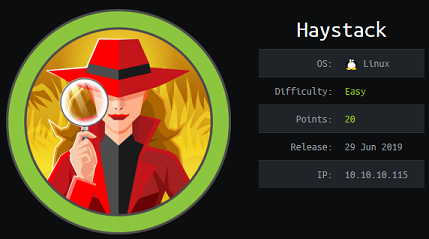 Haystack is an easy ctf-like box where the initial credentials can be found hidden in an ElasticSearch database. Knowing some ES API syntax it’s very easy to retrieve the credentials then get an SSH shell. After exploiting CVE-2018-17246 in Kibana, I get another shell with user kibana who has read access on the configuration for logstash which is running as root. The logstash configuration will run as root any command placed in a specific logstash directory/file so once I figured that out it was easy to get a root shell.
Haystack is an easy ctf-like box where the initial credentials can be found hidden in an ElasticSearch database. Knowing some ES API syntax it’s very easy to retrieve the credentials then get an SSH shell. After exploiting CVE-2018-17246 in Kibana, I get another shell with user kibana who has read access on the configuration for logstash which is running as root. The logstash configuration will run as root any command placed in a specific logstash directory/file so once I figured that out it was easy to get a root shell.
 Safe was a bit of a surprise because I didn’t expect a 20 points box to start with a buffer overflow requiring ropchains. The exploit is pretty straightforward since I have the memory address of the system function and I can call it to execute a shell. The privesc was a breeze: there’s a keepass file with a bunch of images in a directory. I simply loop through all the images until I find the right keyfile that I can use with John the Ripper to crack the password and recover the root password from the keepass file.
Safe was a bit of a surprise because I didn’t expect a 20 points box to start with a buffer overflow requiring ropchains. The exploit is pretty straightforward since I have the memory address of the system function and I can call it to execute a shell. The privesc was a breeze: there’s a keepass file with a bunch of images in a directory. I simply loop through all the images until I find the right keyfile that I can use with John the Ripper to crack the password and recover the root password from the keepass file.
 Writeup starts off easy with an unauthenticated vulnerability in CMS Made Simple that I exploit to dump the database credentials. After cracking the user hash, I can log in to the machine because the user re-used the same password for SSH. The priv esc is pretty nice: I have write access to /usr/local and I can write a binary payload in there that gets executed by run-parts when I SSH in because it’s called without the full path. Another nice box by jkr.
Writeup starts off easy with an unauthenticated vulnerability in CMS Made Simple that I exploit to dump the database credentials. After cracking the user hash, I can log in to the machine because the user re-used the same password for SSH. The priv esc is pretty nice: I have write access to /usr/local and I can write a binary payload in there that gets executed by run-parts when I SSH in because it’s called without the full path. Another nice box by jkr.
 Ghoul was a tricky box from Minatow that required pivoting across 3 containers to find the bits and pieces needed to get root. To get a shell I used a Zip Slip vulnerability in the Java upload app to drop a PHP meterpreter payload on the webserver. After pivoting and scanning the other network segment I found a Gogs application server that is vulnerable and I was able to get a shell there. More credentials were hidden inside an archive file and I was able to use the root shell on one of the container to hijack the SSH agent socket from a connecting root user and hop onto the host OS.
Ghoul was a tricky box from Minatow that required pivoting across 3 containers to find the bits and pieces needed to get root. To get a shell I used a Zip Slip vulnerability in the Java upload app to drop a PHP meterpreter payload on the webserver. After pivoting and scanning the other network segment I found a Gogs application server that is vulnerable and I was able to get a shell there. More credentials were hidden inside an archive file and I was able to use the root shell on one of the container to hijack the SSH agent socket from a connecting root user and hop onto the host OS.
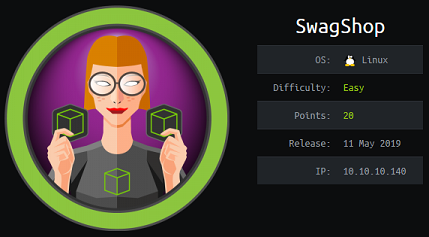 SwagShop is one of those easy boxes where you can pop a shell just by using public exploits. It’s running a vulnerable Magento CMS on which we can create an admin using an exploit then use another one to get RCE. To privesc I can run vi as root through sudo and I use a builtin functionality of vi that allows users to execute commands from vi so I can get root shell.
SwagShop is one of those easy boxes where you can pop a shell just by using public exploits. It’s running a vulnerable Magento CMS on which we can create an admin using an exploit then use another one to get RCE. To privesc I can run vi as root through sudo and I use a builtin functionality of vi that allows users to execute commands from vi so I can get root shell.
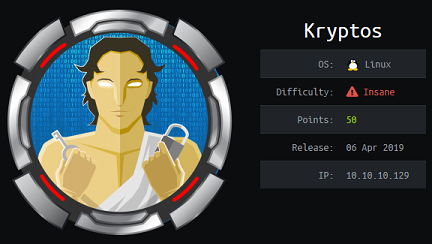 I loved the Kryptos machine from Adamm and no0ne. It starts with a cool parameter injection in the DSN string so I can redirect the DB queries to my VM and have the webserver authenticate to a DB I control. Next is some crypto with the RC4 stream cipher in the file encryptor web app to get access to a protected local web directory and an LFI vulnerability in the PHP code that let me read the source code. After, there’s an SQL injection and I use stacked queries with sqlite to gain write access and RCE by writing PHP code. After finding an encrypted vim file, I’ll exploit a vulnerability in the blowfish implementation to recover the plaintext and get SSH credentials. For the priv esc, I pop a root shell by evading an eval jail in a SUID python webserver and exploiting a broken PRNG implementation.
I loved the Kryptos machine from Adamm and no0ne. It starts with a cool parameter injection in the DSN string so I can redirect the DB queries to my VM and have the webserver authenticate to a DB I control. Next is some crypto with the RC4 stream cipher in the file encryptor web app to get access to a protected local web directory and an LFI vulnerability in the PHP code that let me read the source code. After, there’s an SQL injection and I use stacked queries with sqlite to gain write access and RCE by writing PHP code. After finding an encrypted vim file, I’ll exploit a vulnerability in the blowfish implementation to recover the plaintext and get SSH credentials. For the priv esc, I pop a root shell by evading an eval jail in a SUID python webserver and exploiting a broken PRNG implementation.
 Luke is a easy machine that doesn’t have a lot steps but we still learn a few things about REST APIs like how to authenticate to the service and get a JWT token and which headers are required when using that JWT. The rest of the box was pretty straighforward with some gobuster enumeration, finding PHP sources files with credentials then finally getting a shell through the Ajenti application.
Luke is a easy machine that doesn’t have a lot steps but we still learn a few things about REST APIs like how to authenticate to the service and get a JWT token and which headers are required when using that JWT. The rest of the box was pretty straighforward with some gobuster enumeration, finding PHP sources files with credentials then finally getting a shell through the Ajenti application.
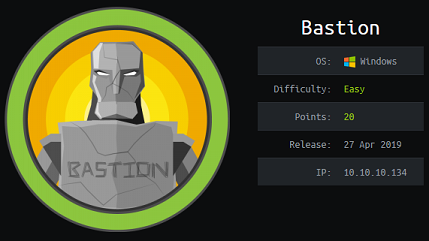 Bastion was an easy box where we had to find an open SMB share that contained a Windows backup. Once we mounted the disk image file, we could recover the system and SAM hive and then crack one of the user’s password. An OpenSSH service was installed on the machine so we could SSH in with the credentials and do further enumeration on the box. We then find a mRemoteNG configuration file that contains encrypted credentials for the administrator. The system flag blood was still up for grab when I reached that stage so instead of reversing the encryption for the configuration file I just installed the mRemoteNG application on a Windows VM, copied the config file over and was able to log in as administrator.
Bastion was an easy box where we had to find an open SMB share that contained a Windows backup. Once we mounted the disk image file, we could recover the system and SAM hive and then crack one of the user’s password. An OpenSSH service was installed on the machine so we could SSH in with the credentials and do further enumeration on the box. We then find a mRemoteNG configuration file that contains encrypted credentials for the administrator. The system flag blood was still up for grab when I reached that stage so instead of reversing the encryption for the configuration file I just installed the mRemoteNG application on a Windows VM, copied the config file over and was able to log in as administrator.
 OneTwoSeven starts with enumeration of various files on the system by creating symlinks from the SFTP server. After finding the credentials for the ots-admin user in a vim swap file, I get access to the administration page by SSH port-forwarding my way in and then I have to use the addon manager to upload a PHP file and get RCE. The priv esc was pretty fun and unique: I had to perform a MITM attack against apt-get and upload a malicious package that executes arbitrary code as root.
OneTwoSeven starts with enumeration of various files on the system by creating symlinks from the SFTP server. After finding the credentials for the ots-admin user in a vim swap file, I get access to the administration page by SSH port-forwarding my way in and then I have to use the addon manager to upload a PHP file and get RCE. The priv esc was pretty fun and unique: I had to perform a MITM attack against apt-get and upload a malicious package that executes arbitrary code as root.
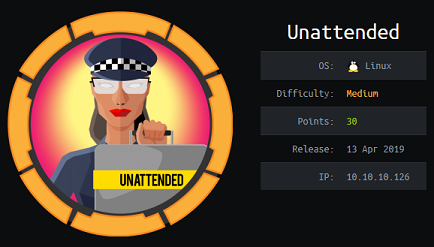 Unattended was a pretty tough box with a second order SQL injection in the PHP app. By injecting PHP code into the web server access logs through the User-Agent header, I can get RCE by including the logs using the SQL injection. I didn’t quite understand what the priv esc was about though. I found the initrd archive and stumbled upon the contents by doing a grep on the box author’s name.
Unattended was a pretty tough box with a second order SQL injection in the PHP app. By injecting PHP code into the web server access logs through the User-Agent header, I can get RCE by including the logs using the SQL injection. I didn’t quite understand what the priv esc was about though. I found the initrd archive and stumbled upon the contents by doing a grep on the box author’s name.
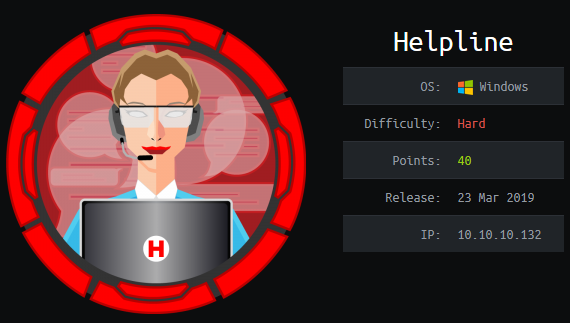 I did Helpline the unintended way by gaining my initial shell access as NT AUTHORITY\SYSTEM and then working my way back to the root and user flags. Both flags were encrypted for two different users so even with a SYSTEM shell I couldn’t immediately read the files and had to find the user plaintext credentials first. The credentials for user Tolu were especially hard to find: they were hidden in Windows Event Log files and I had to use a Python module to parse those.
I did Helpline the unintended way by gaining my initial shell access as NT AUTHORITY\SYSTEM and then working my way back to the root and user flags. Both flags were encrypted for two different users so even with a SYSTEM shell I couldn’t immediately read the files and had to find the user plaintext credentials first. The credentials for user Tolu were especially hard to find: they were hidden in Windows Event Log files and I had to use a Python module to parse those.